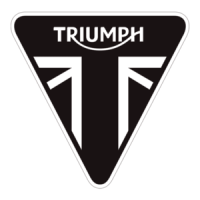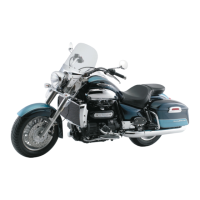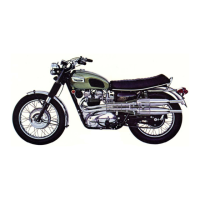Electric Horn
.-
i
If the horn become: unccrtxin in
its
zction, giving only a choking sound, or does no:
vibrate,
it
does not follow that the horn has broken down. First ascertain that the
trouble
is
not due
to
some outside source, e.g. a discharged battery, a loose con-
nection, or short circuit in the wiring of the horn. In part~cular, ascertain that the
horn push bracket is in good electrical contact with the handlebars.
It
is also possible that the performance of a horn may be upset by
its
mounting
becoming loose.
Adjustment
The following adjustment will not alter the tone of the horn.
It
will take up any wear
ofthe moving parts which, if not corrected, may result in loss of power and roughness
of note.
Accurate adjuscmenc requires the use of a 0-10 amp.
D.C.
ammeter-the maximum
permissible current consumption being
6
amperes at
6
volts-but the owner rider,
who may not possess one of these instruments can carry out the following procedure
if the horn note
is
considered to have deteriorated:-
Operate the horn push and turn the adjustment screw anti-clockwise until the
horn just fails
to
sound. Release the horn push and turn the adjustment screw
clockwise for six notches, i.e. a quarter of a turn, when the original performance
should be restored. If further adjustment
is
necessary, turn the screw one
notch at a time.
If the original performance cannot be restored by adjustment do not attempt
to dismantle the horn; but return
it
to a Lucas Service Depot for examination.
SPARKING
PLUGS
The sparking plug
is
of great importance in satisfactory engine performance and every
care should be taken
ro
tic the correct type when replacements are necessary.
There
is
little to be gained by experimenting with different types of plugs as the type
fitted
to
standard equipment, are best suited to your particular engine. !See
Technical Data for your Machine).
Sparking plugs required for racing purposes are
much "harder" and advice on such matters should be obtained from the manufacturers.
The correcr gap setting of the sparking plug
is
.018" (0.45 mm.) (Magneto Ignition)
and 0.020" (0.50 mm.) (Coil ignition). Do not guess this distance but use a feeler
gauge which can be supplied by the plug manufacturer
at
a
very reasonable cost.
When re-setting, bend the side electrode only.
Never bend the centre electrode
as this may split the insulator tip.
The
TR5 and TI00 are fitted with long reach plugs which are screwed directly into
the alloy cylinder head. If either plug indicates tightness when removing, pour
a
little penetrating oil around the base of the plug and allow
it
to seep around the
threads. By doing this the plug will be more easily removed and the cylinder head
plug threads will not be damaged. Smear the threads with graphite grease before
replaclng.

